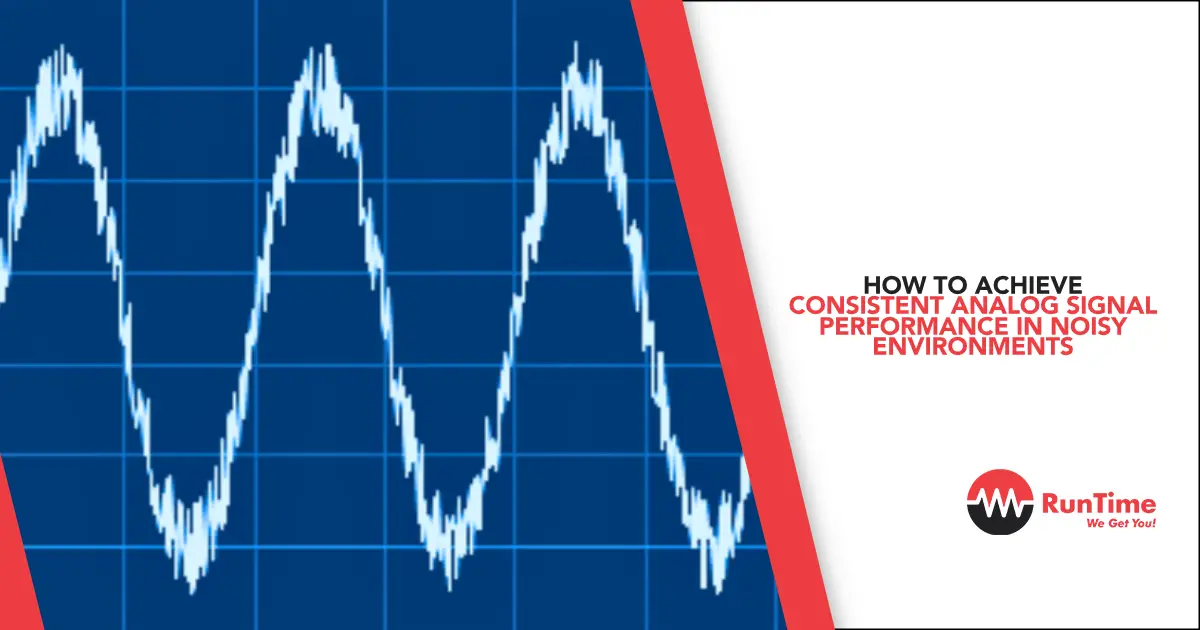In the realm of electronics and communications, achieving consistent analog signal performance in noisy environments is a critical endeavor. Whether in industrial settings, consumer electronics, or scientific instruments, the quality of analog signals can be severely compromised by environmental noise. This challenge necessitates a deep understanding of signal processing techniques, noise reduction methods, and circuit design principles.
By implementing robust shielding, proper grounding strategies, and advanced filtering mechanisms, engineers can mitigate the impact of noise on analog signals. Additionally, leveraging differential signaling, low-noise components, and signal conditioning circuits can further enhance signal integrity.
In this dynamic landscape where precision and reliability are paramount, mastering the art of maintaining analog signal fidelity amidst noise is a fundamental skill for engineers and designers. This introduction sets the stage for exploring the strategies and best practices that enable the consistent performance of analog signals in the face of disruptive noise.
Fundamentals of Analog Signal Performance
Factors Affecting Analog Signal Quality
Analog signals are the foundation of communication and electronic systems, playing a critical role in ensuring the accuracy and reliability of data transmission. The quality of analog signals is influenced by various factors that engineers must carefully consider to optimize performance. Let’s explore some key factors affecting analog signal quality:.
- Signal-to-Noise Ratio (SNR)
The Signal-to-Noise Ratio (SNR) is a measure of the level of desired signal compared to background noise. A high SNR indicates better signal quality, while a low SNR can lead to errors in signal interpretation. Engineers often employ techniques like signal amplification and noise filtering to improve SNR.
- Bandwidth
Bandwidth refers to the range of frequencies that an analog signal can carry effectively. Insufficient bandwidth can result in signal distortion and loss of information. Engineers must ensure that the system’s bandwidth matches the signal requirements to prevent data loss.
- Distortion
Distortion alters the original shape of the analog signal waveform, impacting signal accuracy. Common causes of distortion include non-linearities in electronic components and signal interference. Minimizing distortion is crucial for maintaining signal integrity.
- Interference
Interference occurs when unwanted signals disrupt the transmission of the desired signal. External factors such as electromagnetic interference (EMI) and radio frequency interference (RFI) can introduce noise and distort the analog signal. Shielding and proper grounding techniques are essential to mitigate interference.
- Attenuation
Attenuation refers to the weakening of the signal as it travels through a medium or components. Factors like cable length, impedance mismatches, and environmental conditions can contribute to signal attenuation. Signal amplification and impedance matching are used to compensate for attenuation and maintain signal strength.
Impact of Noise on Analog Signals
Noise is an inherent aspect of analog signal processing that can degrade signal quality and introduce errors. Understanding the types of noise that affect analog signals is crucial for implementing effective noise reduction strategies. Let’s explore some common types of noise:.
- Thermal Noise
Thermal noise, also known as Johnson-Nyquist noise, is generated by the random motion of electrons in conductors at finite temperatures. It is present in all electronic circuits and increases with temperature. Proper circuit design and shielding techniques can help minimize thermal noise.
- Shot Noise
Shot noise is caused by the discrete nature of current flow in electronic devices. It is prevalent in devices like semiconductor diodes and photodetectors. Balancing shot noise with other sources of noise is essential for optimizing signal quality.
- Flicker Noise
Flicker noise, also referred to as 1/f noise, is characterized by its frequency dependence, with higher levels at lower frequencies. It can impact low-frequency analog signals and is a common concern in precision analog circuits. Mitigating flicker noise often involves careful component selection and layout design.
- Impulse Noise
Impulse noise consists of sudden, short-duration spikes or disturbances in the signal. It can be caused by external sources like electromagnetic interference or internal faults in electronic components. Implementing robust noise filtering and transient suppression measures is crucial for managing impulse noise.
In this comprehensive section, we have explored the fundamental factors influencing analog signal quality and the diverse types of noise that can affect signal performance. By understanding these concepts and implementing appropriate design practices, engineers can enhance the reliability and efficiency of analog signal processing in various applications.
The Influence of Noise on Analog Signals
Noise in analog signals is a pervasive challenge that engineers face in various electronic systems. It can significantly affect signal integrity and overall system performance. Let’s delve deeper into the categories of noise in analog signals and explore the profound effects it has on signal quality.
Categories of Noise in Analog Signals
- Thermal Noise
- Shot Noise
- Flicker Noise
- Burst Noise
Thermal noise, also known as Johnson-Nyquist noise, is generated by the random motion of electrons in a conductor due to thermal energy. Shot noise, on the other hand, occurs when a current is carried by discrete charges, leading to fluctuations in the signal. Flicker noise, characterized by its frequency dependence, is often present in semiconductors and can pose challenges in low-frequency applications. Burst noise, sometimes referred to as popcorn noise, appears intermittently and can be particularly troublesome in sensitive analog circuits.
Effects of Noise on Signal Integrity
The impact of noise on signal integrity is profound and multifaceted. Noise can manifest in various ways, including:.
- Signal Distortion: Noise can distort the original signal waveform, leading to inaccuracies in data transmission.
- Reduction in Signal-to-Noise Ratio (SNR): As noise levels increase, the SNR decreases, affecting the quality of the signal.
- Interference with Signal Processing: Noise can interfere with signal processing algorithms, causing errors and disrupting communication.
To combat the adverse effects of noise, engineers employ a range of mitigation techniques such as filtering, shielding, and amplification. Proper grounding and layout design also play a crucial role in minimizing noise susceptibility.
In modern electronic systems, with the increasing complexity and sensitivity of analog components, managing noise has become more challenging. High-speed digital circuits, for instance, can introduce electromagnetic interference that affects nearby analog components. Understanding the frequency spectrum of noise sources is crucial for effective filtering and suppression.
Moreover, advancements in noise cancellation technologies, such as adaptive filtering algorithms and noise-cancelling circuits, have enabled engineers to achieve higher signal fidelity in noisy environments. Real-time signal processing techniques and digital signal processing algorithms have also proven instrumental in reducing noise artifacts and enhancing signal clarity.
The influence of noise on analog signals underscores the importance of robust noise mitigation strategies in electronic design. By staying informed about the types of noise, their sources, and effects, engineers can proactively address noise-related challenges and ensure optimal signal integrity in analog systems.
Strategies for Ensuring Consistent Analog Signal Performance
Effective Signal Filtering Methods
In the realm of analog signal processing, the significance of employing effective signal filtering methods cannot be overstated. By implementing appropriate filters, such as low-pass, high-pass, band-pass, and band-stop filters, engineers can significantly enhance the performance and reliability of analog signal transmission. This section will delve into the intricacies of each filter type, discussing their unique characteristics, applications, and advantages in various circuit designs. Furthermore, we will explore advanced filtering techniques, including active and passive filters, to provide a comprehensive understanding of signal filtering strategies.
Best Practices in Grounding and Shielding
Ensuring proper grounding and shielding is paramount in maintaining signal integrity and minimizing noise interference in analog circuits. By adhering to best practices such as star grounding, ground loop elimination, and effective isolation techniques, engineers can create robust circuit designs that exhibit superior performance in noise-sensitive environments. This segment will also highlight the importance of utilizing high-quality grounding materials and shielded enclosures to mitigate electromagnetic interference and ground loops effectively.
Optimizing Component Placement and Layout
The layout and placement of components play a pivotal role in determining the overall performance of analog circuits. Engineers must pay meticulous attention to factors such as component orientation, signal routing, and thermal considerations to minimize signal distortion, crosstalk, and interference. This section will provide detailed insights into advanced layout optimization techniques, including signal path length optimization, controlled impedance routing, and thermal management strategies, to maximize signal integrity and minimize signal degradation.
Implementation of Noise Reduction Algorithms
In the quest for pristine analog signal quality, the implementation of noise reduction algorithms emerges as a powerful tool in combating environmental noise sources. By leveraging sophisticated algorithms like digital filtering, adaptive filtering, and spectral subtraction, engineers can effectively suppress noise artifacts and enhance signal clarity in challenging operating conditions. Real-world case studies and practical examples will be presented to showcase the efficacy of these algorithms in real-time noise mitigation scenarios.
Selection of High-Quality Components
The selection of high-quality components serves as the cornerstone of achieving consistent analog signal performance. Engineers must meticulously evaluate component specifications, including noise figure, distortion characteristics, bandwidth limitations, and linearity, to ensure optimal system functionality. This section will provide a comprehensive guide on selecting components from reputable manufacturers, conducting rigorous performance testing, and validating component compatibility to guarantee reliable analog signal transmission across diverse applications.
Validation and Testing Approaches
In the realm of developing cutting-edge technology, validation and testing are crucial steps to ensure the reliability and efficiency of the final product. In this blog section, we will delve into various approaches used for validating and testing innovative solutions.
Utilizing Simulation Tools for Signal Analysis
One of the key methodologies in the validation process is the use of simulation tools for signal analysis. By creating virtual environments that mimic real-world scenarios, engineers can assess how a system performs under different conditions. This approach not only saves time and resources but also enables thorough testing without the need for physical prototypes.
Real-World Testing in Noisy Environments
While simulation tools are valuable, real-world testing in noisy environments is equally essential. It is crucial to subject the technology to various external factors and disturbances to evaluate its robustness. This approach helps in identifying potential weaknesses and fine-tuning the system for optimal performance in practical settings.
Evaluation Metrics and Benchmarks
Establishing clear evaluation metrics and benchmarks is vital for quantifying the performance of a technology. By defining specific criteria for success, developers can objectively assess the outcomes of the testing phase. This step not only ensures that the product meets the desired standards but also provides a basis for comparison with existing solutions.
Challenges in Validation and Testing
Despite the advancements in simulation tools and real-world testing, there are challenges that engineers face during the validation and testing phases. Issues such as hardware limitations, environmental variability, and unexpected interactions can impact the accuracy of test results. Overcoming these challenges requires innovative solutions, continuous monitoring, and adaptive testing strategies.
Automation in Testing
Automation plays a significant role in streamlining the validation and testing processes. Automated test scripts, continuous integration, and regression testing help in identifying defects early in the development cycle, reducing time-to-market, and improving overall product quality. Embracing automation tools and frameworks can enhance efficiency and accuracy in testing procedures.
Future Trends in Validation and Testing
Looking ahead, the future of validation and testing is poised for exciting advancements. Trends such as AI-driven testing, virtual testing environments, and predictive analytics are set to revolutionize how engineers validate and test technology. By leveraging these emerging technologies, developers can expedite the testing phase, uncover hidden defects, and deliver robust solutions to meet evolving market demands.
A comprehensive validation and testing strategy that incorporates simulation tools, real-world testing, precise evaluation metrics, addresses challenges, embraces automation, and adapts to future trends is essential for driving innovation and delivering reliable technologies to the market.
Case Studies: Successes and Failures
Exemplary Cases of Analog Signal Performance Enhancement
- Implementing Advanced Filtering Techniques: A case study on how incorporating sophisticated filtering algorithms led to a significant reduction in noise interference, resulting in enhanced signal clarity. The implementation of adaptive filters such as Kalman filters and wavelet transforms played a crucial role in isolating the signal of interest from background noise, showcasing a remarkable improvement in signal-to-noise ratio.
- Optimizing Signal Amplification: Exploring a successful project where precise adjustment of signal amplification parameters improved signal strength without introducing distortion. By utilizing state-of-the-art amplifiers with adjustable gain levels, the project achieved a balance between amplification and fidelity, ensuring that the signal remained robust throughout the transmission chain.
- Leveraging Adaptive Signal Processing: A detailed analysis of how adaptive signal processing algorithms were utilized to dynamically adjust signal parameters, achieving optimal performance under varying conditions. The incorporation of adaptive equalization techniques and neural network-based signal processing enabled real-time adjustments to signal characteristics, resulting in adaptive responses to changing environmental factors.
Additional examples of successful signal optimization strategies include:.
- Signal Modulation Techniques: Highlighting a case where the implementation of advanced modulation schemes such as QAM (Quadrature Amplitude Modulation) significantly improved data transmission rates and spectral efficiency. By intelligently modulating the signal, the project achieved higher throughput while maintaining signal integrity.
- Noise Cancellation Technologies: Discussing a successful integration of noise cancellation technologies like active noise control and adaptive beamforming to mitigate external noise sources. This approach enhanced signal clarity by actively suppressing unwanted noise components, leading to superior signal quality in challenging acoustic environments.
Lessons Learned from Failed Signal Optimization Attempts
- Overlooking Signal Integrity Issues: A case study highlighting the consequences of neglecting signal integrity considerations, resulting in signal degradation despite optimization efforts. By neglecting factors such as impedance matching and signal attenuation, the optimization process failed to address underlying integrity issues, leading to degraded signal quality and reliability.
- Inadequate Noise Reduction Strategies: An examination of a failed attempt to enhance signal quality due to ineffective noise reduction strategies, emphasizing the importance of comprehensive noise management. The absence of proper shielding techniques and the lack of consideration for electromagnetic interference mitigation resulted in persistent noise contamination, undermining the effectiveness of signal optimization initiatives.
- Mismanagement of Signal-to-Noise Ratio: A case study demonstrating the impact of mismanaging the signal-to-noise ratio during optimization, leading to suboptimal results and performance limitations. Inadequate signal grounding practices and improper signal routing contributed to an imbalance in signal clarity, highlighting the significance of maintaining a favorable signal-to-noise ratio for optimal system performance.
In summary, successful signal optimization relies on a combination of advanced techniques, precise parameter adjustments, and adaptive processing methods to enhance signal performance across various applications. By learning from both successful implementations and failed attempts, engineers and researchers can refine their approaches and drive further innovations in analog signal processing for improved system functionality and reliability.
Conclusion
Achieving consistent analog signal performance in noisy environments requires a combination of proper circuit design, signal conditioning, and noise reduction techniques. By carefully selecting components, shielding sensitive areas, and implementing filtering methods, engineers can mitigate the impact of noise and ensure reliable operation of analog systems. It is crucial to understand the characteristics of the noise sources and tailor the design accordingly to maintain signal integrity. With attention to detail and adherence to best practices, consistent analog signal performance can be achieved even in challenging noisy environments.
Check out our partner, Transient Specialists, who have created a helpful guide on 6 Types of EMC Test Equipment Applications. It breaks down the main types of EMC testing equipment and where each is applied, a useful reference for engineers working to ensure compliance and optimize signal integrity in real-world designs.









